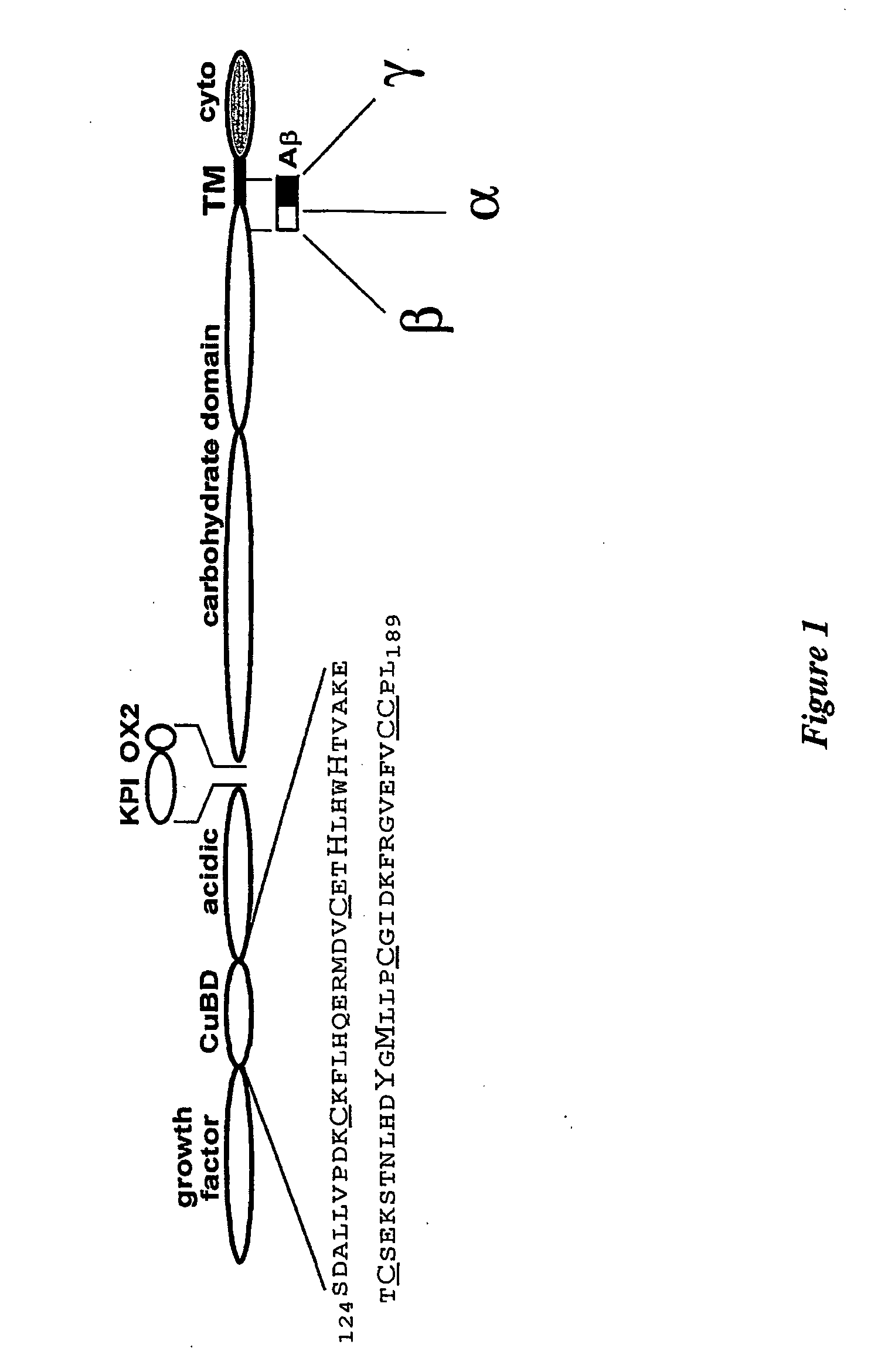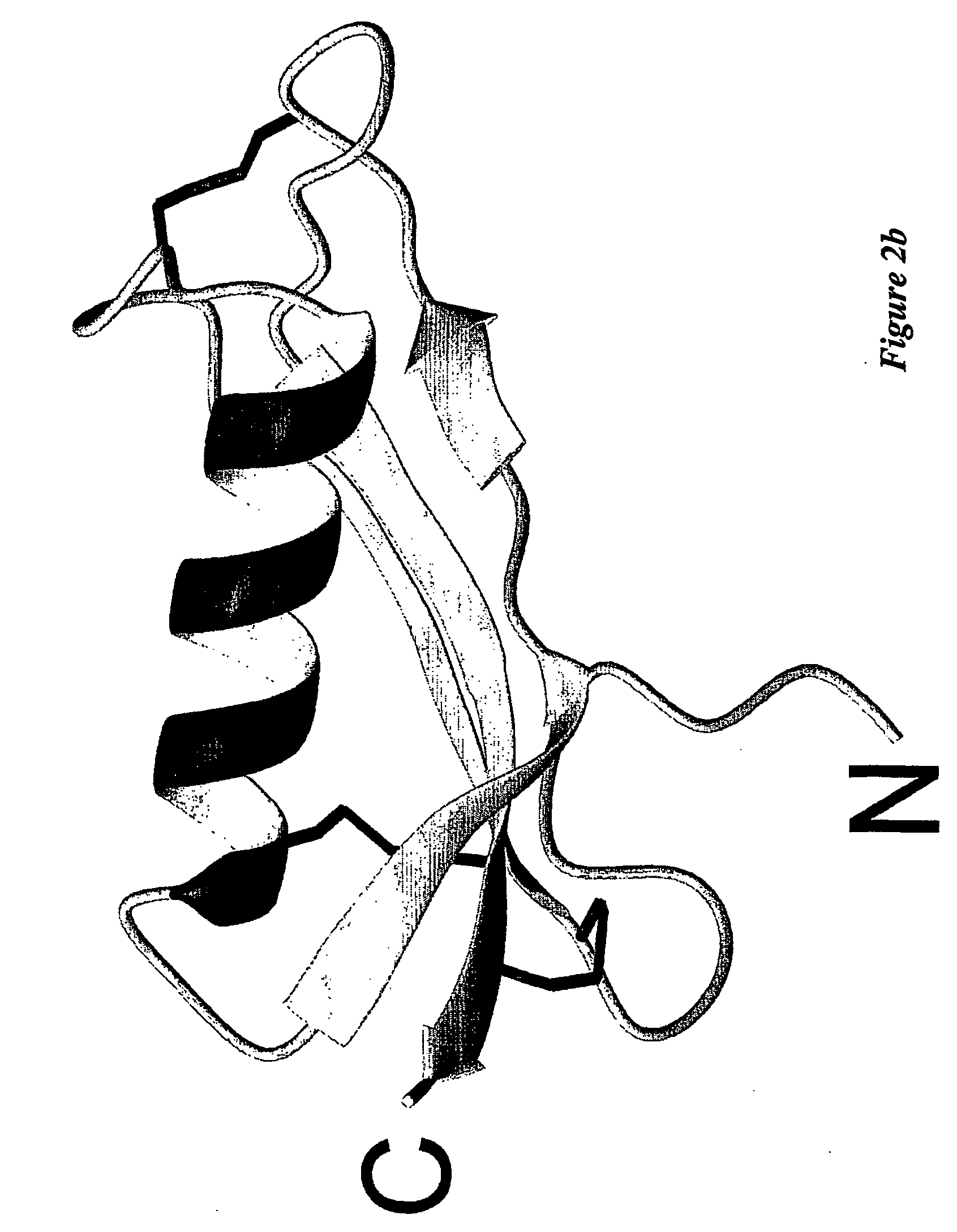Method for screening for inhibitors of alzheimer's disease
a technology for alzheimer's disease and inhibitors, applied in the field of screening for alzheimer's disease inhibitors, can solve the problems of undetermined rational chemical and structural basis for developing effective drugs to prevent or cure the disease, and the physiological function of app has not yet been established, so as to reduce the production of a and inhibit the production of toxic cu(i) ions
- Summary
- Abstract
- Description
- Claims
- Application Information
AI Technical Summary
Benefits of technology
Problems solved by technology
Method used
Image
Examples
example 1
Expression and Purification of Recombinant APP124-189 and APP133-189
[0130] The sequence encoding APP124-189 (SEQ ID NO:1) was amplified by PCR using the primers
GCT CGA GAA AA GAG AGG CTA GTG ATG CCC TTC TCG
[0131] (primer 1; SEQ ID NO:2) and
GAA TTC TTA CAG TGG GCA ACA CAC AAA CTC
[0132] (primer 2; SEQ ID NO:3).
[0133] The PCR product was cloned as a XhoI-EcoRI fragment into the Pichia pastoris vector pIC9 (Invitrogen) and then transformed into P. pastoris strain GS115 as previously described (Henry et al., 1997). Expressing clones were identified by analysing the culture supernatants by silver stain-SDS-PAGE.
[0134] APP 124-189, whose structure is shown schematically in FIG. 1, was expressed as a secreted protein in the yeast Pichia pastoris and purified by a two-step purification scheme to homogeneity, as judged by mass spectroscopy and N-terminal sequencing.
[0135] Isotopically-labelled protein was prepared by the protocol of Laroche et al (Laroche et al., 1994). 15N-single l...
example 2
NMR Spectroscopy and Spectral Assignments
[0138] NMR spectra were acquired at 30° C. using a Bruker DRX-600 spectrometer equipped with triple-resonance pulsed-field gradient probes. Sequential resonance assignments were made using a series of triple resonance spectra (Sattler et al., 1999) acquired on either uniformly 15N— or 13C, 15N-labelled APP124-189 using the methods described by Day et al. (1999). Spectra were obtained on samples which typically contained 0.5 mM protein in 50 mM phosphate buffer (pH 6.9) at 30° C., and 1 mM EDTA, which was either removed or titrated out in the metal-binding studies. APP124-189 had good solution properties at pH 6.9, and was stable for months in the presence of EDTA at 0.5 mM.
[0139] Inductively-coupled plasma mass spectrometry analysis revealed that APP124-189 had very low levels of bound metal, suggesting that it was in the apo form. An essentially complete set of resonance assignments was determined from spectra acquired using 15N and 13C, 1...
example 3
Mutagenesis Data Supporting the His-His-Tyr-Met Binding Site
[0153] The NMR structure indicates that the copper-binding site is composed of His147, His151, Tyr168, Met170. Mutagenesis experiments were performed to test this. His147 and His151 were mutated to Asn, Tyr168 was mutated to Phe, and Met170 was mutated to Leu. These mutations were incorporated into APP133-189. Recombinant protein was expressed in Pichia pastoris as described above, and purified by standard chromatography methods. The identities of the purified proteins were verified by mass spectrometry. The Cu-reducing activity of the CuBD was tested in a lipid peroxidation assay.
[0154] Two different assays of metal mediated lipid peroxidation were utilized. The first assay involved measuring the oxidative activity of metallated proteins. This was determined by mixing dialyzed metallated or native protein at designated concentrations with 0.5 mg / mL low-density lipoprotein (LDL) for 24 hr (37° C.). Lipid peroxidation was ...
PUM
| Property | Measurement | Unit |
|---|---|---|
| pH | aaaaa | aaaaa |
| molecular weight | aaaaa | aaaaa |
| concentration | aaaaa | aaaaa |
Abstract
Description
Claims
Application Information
 Login to View More
Login to View More - R&D
- Intellectual Property
- Life Sciences
- Materials
- Tech Scout
- Unparalleled Data Quality
- Higher Quality Content
- 60% Fewer Hallucinations
Browse by: Latest US Patents, China's latest patents, Technical Efficacy Thesaurus, Application Domain, Technology Topic, Popular Technical Reports.
© 2025 PatSnap. All rights reserved.Legal|Privacy policy|Modern Slavery Act Transparency Statement|Sitemap|About US| Contact US: help@patsnap.com



